Impact Assessment of Timber Harvesting Operations for Enhancing Sustainable Management in a Secondary Atlantic Forest
Abstract
1. Introduction
2. Materials and Methods
2.1. Research Area
2.2. Harvesting Methods
2.3. Analytical Methods
3. Results
3.1. Forest Structure and Harvesting Intensity
3.2. Harvesting Damage
3.3. Geo Analysis
4. Discussion
5. Conclusions
Author Contributions
Funding
Acknowledgments
Conflicts of Interest
References
- Metzger, J.P. Conservation issues in the Brazilian Atlantic forest. Biol. Conserv. 2009, 142, 1138–1140. [Google Scholar] [CrossRef]
- Jacobsen, T.R. Populating the Environment: Human Growth, Density and Migration in the Atlantic Forest. In The Atlantic Forest of South America: Biodiversity, Threats, and Outlook; Galindo-Leal, C., Câmara, I.d.G., Eds.; Island Press: Washington, DC, USA, 2003; pp. 426–435. ISBN 978-1-55963-988-0. [Google Scholar]
- Trevisan, A.C.D.; Schmitt-Filho, A.L.; Farley, J.; Fantini, A.C.; Longo, C. Farmer perceptions, policy and reforestation in Santa Catarina, Brazil. Ecol. Econ. 2016, 130, 53–63. [Google Scholar] [CrossRef]
- Ribeiro, M.C.; Metzger, J.P.; Martensen, A.C.; Ponzoni, F.J.; Hirota, M.M. The Brazilian Atlantic Forest: How much is left, and how is the remaining forest distributed? Implications for conservation. Biol. Conserv. 2009, 142, 1141–1153. [Google Scholar] [CrossRef]
- Fantini, A.C.; Siminski, A. Manejo de florestas secundárias da Mata Atlântica para produção de madeira: Possível e desejável. Revista Brasileira de Pós-Graduação 2017, 13. [Google Scholar] [CrossRef][Green Version]
- Vibrans, A.C.; Sevegnani, L.; de Gasper, A.L.; Lingner, D.V. Inventário Florístico Florestal de Santa Catarina. Vol. 1: Diversidade e Conservação dos Remanescentes Florestais; Universidade Regional de Blumenau, Brasil: Blumenau, Brazil, 2012; ISBN 978-85-7114-330-2. [Google Scholar]
- Lugo, A.E. The Emerging Era of Novel Tropical Forests: Insights. Biotropica 2009, 41, 589–591. [Google Scholar] [CrossRef]
- Fantini, A.C.; Schuch, C.; Siminski, A.; Siddique, I. Small-scale Management of Secondary Forests in the Brazilian Atlantic Forest. Floresta E Ambiente 2019, 26. [Google Scholar] [CrossRef]
- Alarcon, G.G.; Caporal, D.S.; Beltrame, A.D.V.; Karam, K.F. Transformação da paisagem e o uso dos recursos florestais na agricultura familiar: Um estudo de caso em área de Mata Atlântica. Ciência Florest. 2011, 21. [Google Scholar] [CrossRef]
- Britto, P.C.; Jaeger, D.; Hoffmann, S.; Robert, R.C.G.; Fantini, A.C.; Vibrans, A.C. Productivity assessment of timber harvesting techniques for supporting sustainable forest management of secondary Atlantic Forests in southern Brazil. Ann. For. Res. 2017, 60, 203–215. [Google Scholar] [CrossRef]
- Piazza, G.E.; Zambiazi, D.C.; Correia, J.; Fantini, A.C. Regeneração natural de espécies madeireiras na floresta secundária da Mata Atlântica. Adv. For. Sci. 2017, 4, 99–105. [Google Scholar]
- Da Silva, D.A.; Piazza, G.; Fantini, A.C.; Vibrans, A.C. Forest management in a secondary Atlantic Rainforest: Assessing the harvest damage. Adv. For. Sci. 2018, 4, 187–193. [Google Scholar]
- Ruy, C.C.; Weiser, N.H.; Piazza, G.E.; Robert, R.C.G. Danos decorrentes do uso da floresta baseado em conhecimentos tradicionais: Um estudo de caso em uma floresta secundária de Santa Catarina. Enciclopédia Biosf. 2014, 10, 2869–2878. [Google Scholar]
- Bulfe, N.M.L.; Galvão, F.; Filho, A.F.; Donagh, P.M. Efeitos da exploração convencional e de impacto reduzido em uma floresta estacional semidecidual na província de Misiones, nordeste da Argentina. Floresta 2009, 39. [Google Scholar] [CrossRef]
- Spinelli, R.; Magagnotti, N.; Nati, C. Benchmarking the impact of traditional small-scale logging systems used in Mediterranean forestry. For. Ecol. Manag. 2010, 260, 1997–2001. [Google Scholar] [CrossRef]
- Marchi, E.; Picchio, R.; Spinelli, R.; Verani, S.; Venanzi, R.; Certini, G. Environmental impact assessment of different logging methods in pine forests thinning. Ecol. Eng. 2014, 70, 429–436. [Google Scholar] [CrossRef]
- Oliveira-Filho, A.T.; Budke, J.C.; Jarenkow, J.A.; Eisenlohr, P.V.; Neves, D.R.M. Delving into the variations in tree species composition and richness across South American subtropical Atlantic and Pampean forests. J. Plant Ecol. 2015, 8, 242–260. [Google Scholar] [CrossRef]
- Alvares, C.A.; Stape, J.L.; Sentelhas, P.C.; de Moraes Gonçalves, J.L.; Sparovek, G. Köppen’s climate classification map for Brazil. Meteorol. Z. 2013, 22, 711–728. [Google Scholar] [CrossRef]
- Fowler, R.J.; Little, J.J. Automatic Extraction of Irregular Network Digital Terrain Models. In Proceedings of the 6th Annual Conference on Computer Graphics and Interactive Techniques, Chicago, IL, USA, 08–10 August 1979; ACM: New York, NY, USA, 1979; pp. 199–207. [Google Scholar]
- Lingner, D.V.; Schorn, L.A.; Sevegnani, L.; de Gasper, A.L.; Meyer, L.; Vibrans, A.C. Floresta ombrófila densa de Santa Catarina - Brasil: Agrupamento e ordenação baseados em amostragem sistemática. Ciência Florest. 2015, 25, 933–946. [Google Scholar] [CrossRef]
- Hoffmann, S.; Jaeger, D.; Lingenfelder, M.; Schoenherr, S. Analyzing the Efficiency of a Start-Up Cable Yarding Crew in Southern China under New Forest Management Perspectives. Forests 2016, 7, 188. [Google Scholar] [CrossRef]
- Johns, J.S.; Barreto, P.; Uhl, C. Logging damage during planned and unplanned logging operations in the eastern Amazon. For. Ecol. Manag. 1996, 89, 59–77. [Google Scholar] [CrossRef]
- Sist, P.; Ferreira, F.N. Sustainability of reduced-impact logging in the Eastern Amazon. For. Ecol. Manag. 2007, 243, 199–209. [Google Scholar] [CrossRef]
- Jackson, S.M.; Fredericksen, T.S.; Malcolm, J.R. Area disturbed and residual stand damage following logging in a Bolivian tropical forest. For. Ecol. Manag. 2002, 166, 271–283. [Google Scholar] [CrossRef]
- Piponiot, C.; Rödig, E.; Putz, F.E.; Rutishauser, E.; Sist, P.; Ascarrunz, N.; Blanc, L.; Derroire, G.; Descroix, L.; Guedes, M.C.; et al. Can timber provision from Amazonian production forests be sustainable? Env. Res. Lett. 2019, 14, 064014. [Google Scholar] [CrossRef]
- Laurent, M.; Antoine, N.; Joël, G. Effects of different thinning intensities on drought response in Norway spruce (Picea abies (L.) Karst.). For. Ecol. Manag. 2003, 183, 47–60. [Google Scholar] [CrossRef]
- Mäkinen, H.; Isomäki, A. Thinning intensity and growth of Scots pine stands in Finland. For. Ecol. Manag. 2004, 201, 311–325. [Google Scholar] [CrossRef]
- Mäkinen, H.; Isomäki, A. Thinning intensity and growth of Norway spruce stands in Finland. Forestry 2004, 77, 349–364. [Google Scholar] [CrossRef]
- Lopes, E.S.; Oliveira, F.M.; Droog, A. Damage to residual trees following commercial thinning by harvester and forwarder in a Pinus taeda stand in Southern Brazil. Sci. For. 2018, 46. [Google Scholar] [CrossRef]
- Dean, W. With Broadax and Firebrand: The Destruction of the Brazilian Atlantic Forest; University of California Press: Berkeley, CA, USA, 2008; ISBN 978-0-520-20886-5. [Google Scholar]
- Albizu-Urionabarrenetxea, P.; Tolosana-Esteban, E.; Roman-Jordan, E. Safety and health in forest harvesting operations. Diagnosis and preventive actions. A review. For. Syst. 2013, 22, 392. [Google Scholar] [CrossRef]
- Picchio, R.; Tavankar, F.; Bonyad, A.; Mederski, P.S.; Venanzi, R.; Nikooy, M. Detailed Analysis of Residual Stand Damage Due to Winching on Steep Terrains. Small-Scale For. 2019, 18, 255–277. [Google Scholar] [CrossRef]
- Guitet, S.; Pithon, S.; Brunaux, O.; Jubelin, G.; Gond, V. Impacts of logging on the canopy and the consequences for forest management in French Guiana. For. Ecol. Manag. 2012, 277, 124–131. [Google Scholar] [CrossRef]
- Krueger, W. Effects of future crop tree flagging and skid trail planning on conventional diameter-limit logging in a Bolivian tropical forest. For. Ecol. Manag. 2004, 188, 381–393. [Google Scholar] [CrossRef]
- Picchio, R.; Magagnotti, N.; Sirna, A.; Spinelli, R. Improved winching technique to reduce logging damage. Ecol. Eng. 2012, 47, 83–86. [Google Scholar] [CrossRef]
- Verissimo, A.; Barreto, P.; Mattos, M.; Tarifa, R.; Uhl, C. Logging impacts and prospects for sustainable forest management in an old Amazonian frontier: The case of Paragominas. For. Ecol. Manag. 1992, 55, 169–199. [Google Scholar] [CrossRef]
- Magnusson, W.E.; de Lima, O.P.; Quintiliano Reis, F.; Higuchi, N.; Ferreira Ramos, J. Logging activity and tree regeneration in an Amazonian forest. Forest Ecol. Manag. 1999, 113, 67–74. [Google Scholar] [CrossRef]
- Panfil, S.N.; Gullison, R.E. Short term impacts of experimental timber harvest intensity on forest structure and composition in the Chimanes Forest, Bolivia. For. Ecol. Manag. 1998, 102, 235–243. [Google Scholar] [CrossRef]
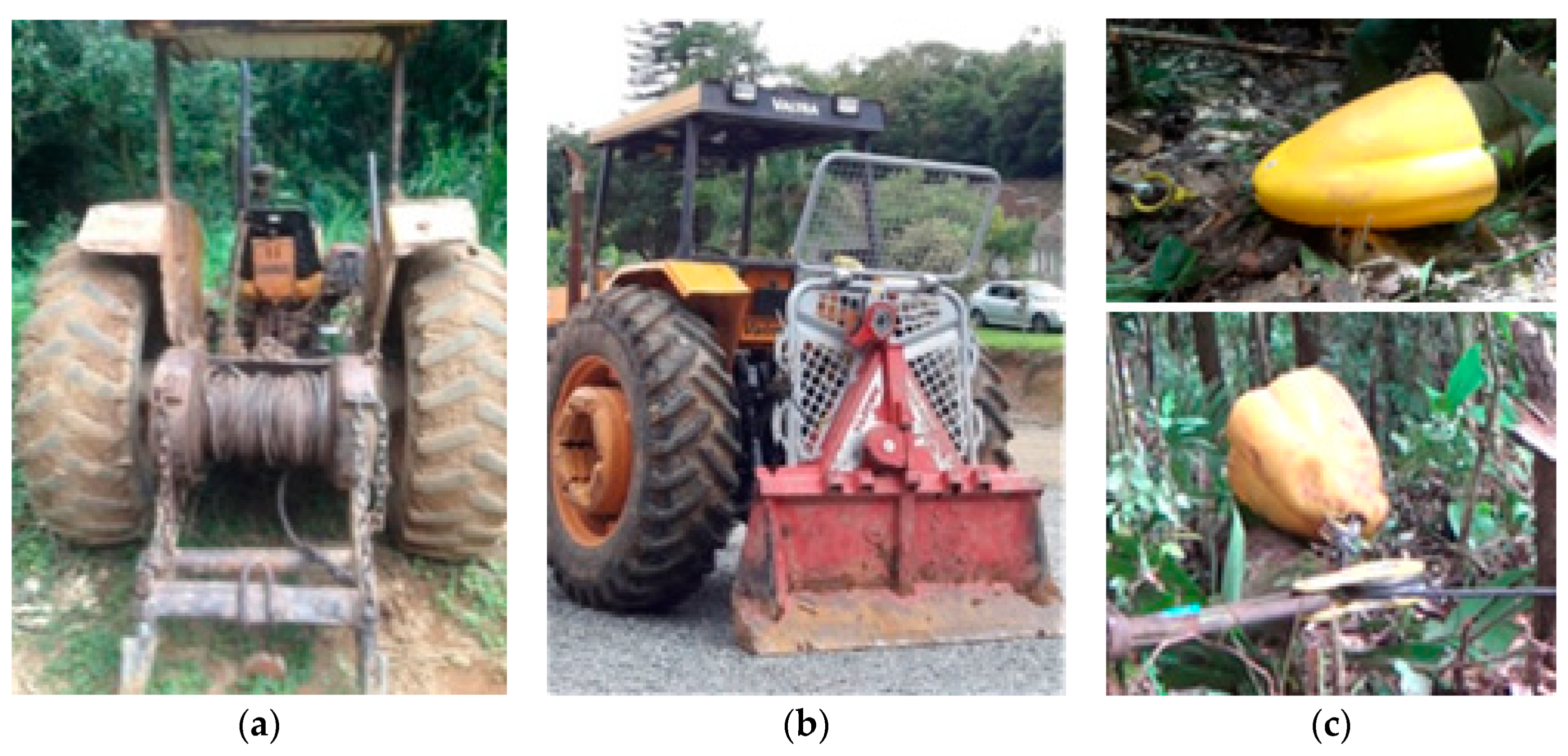
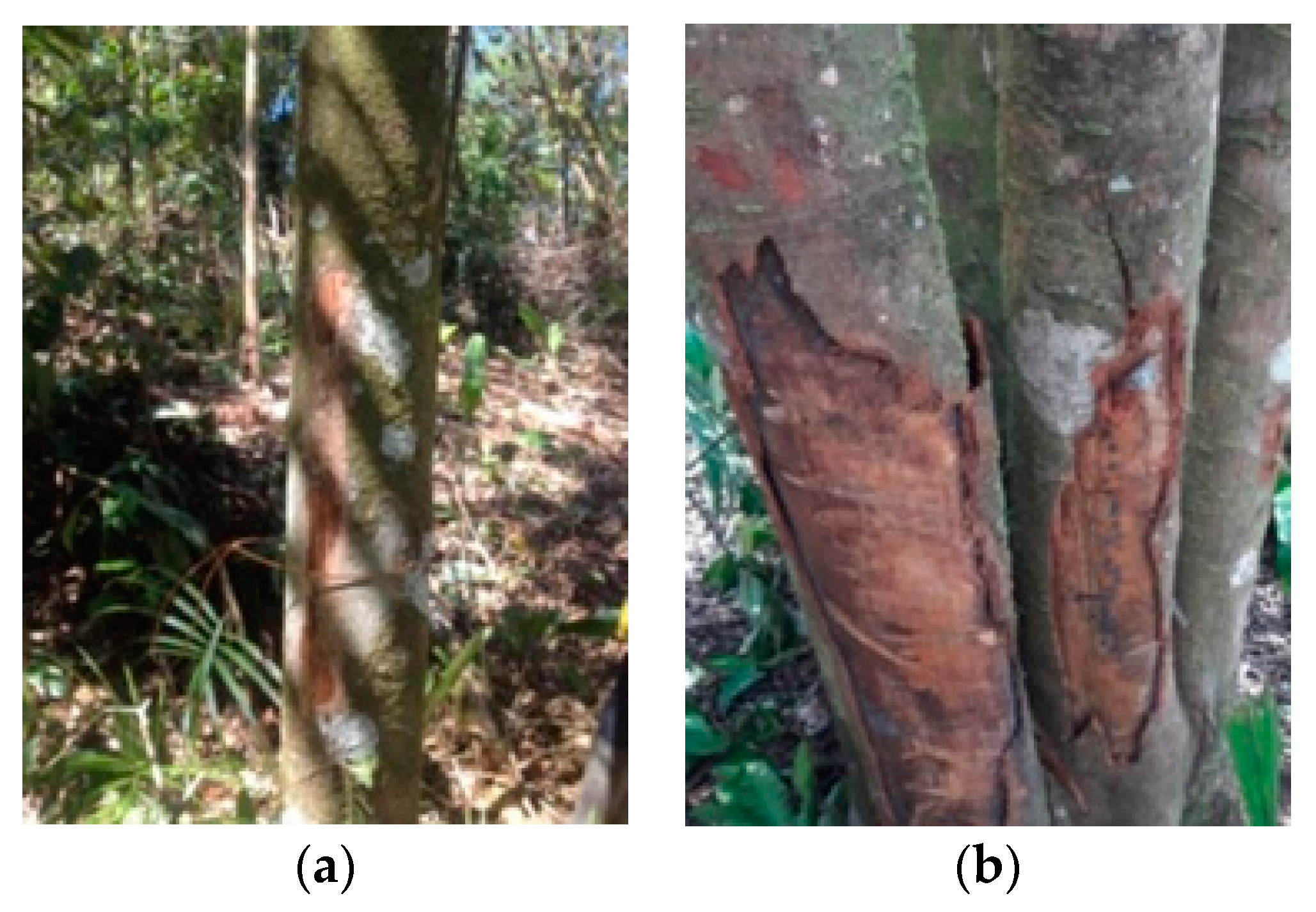
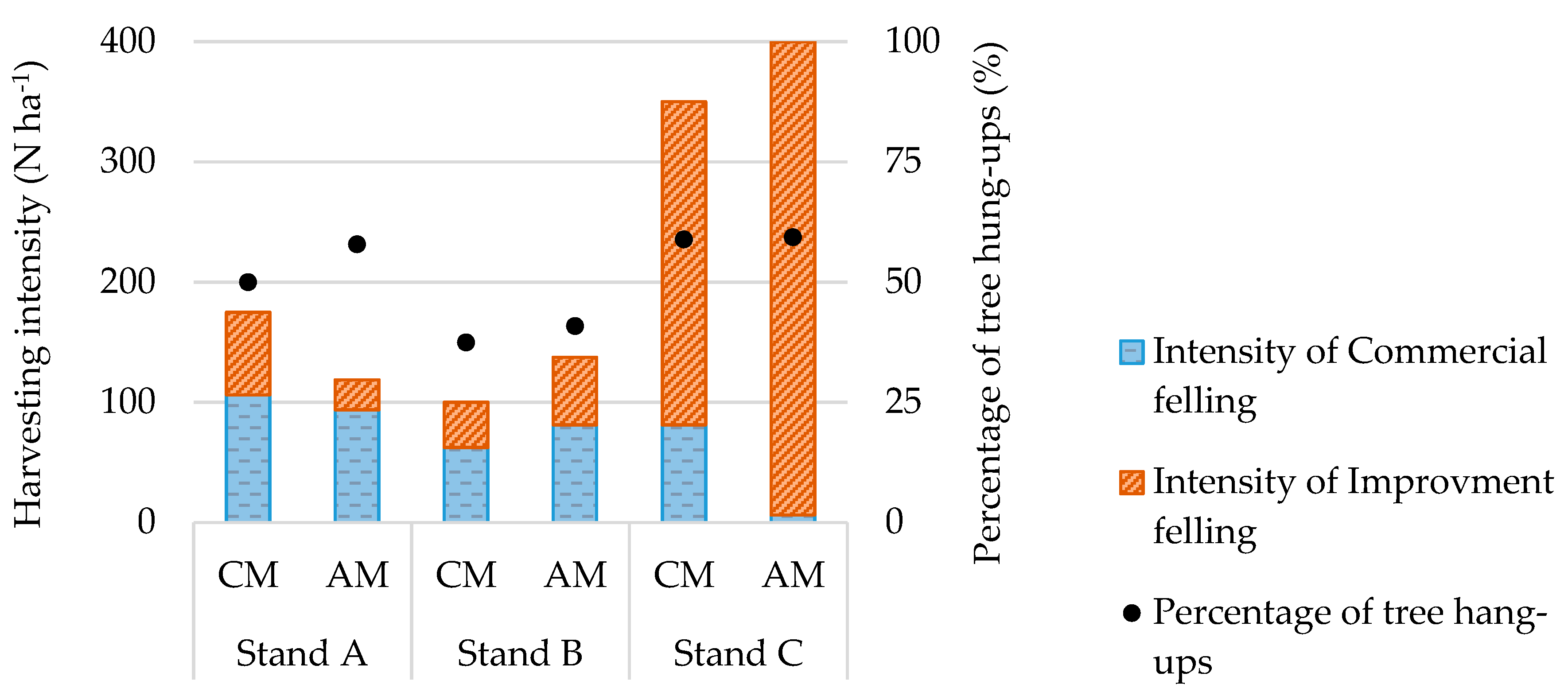

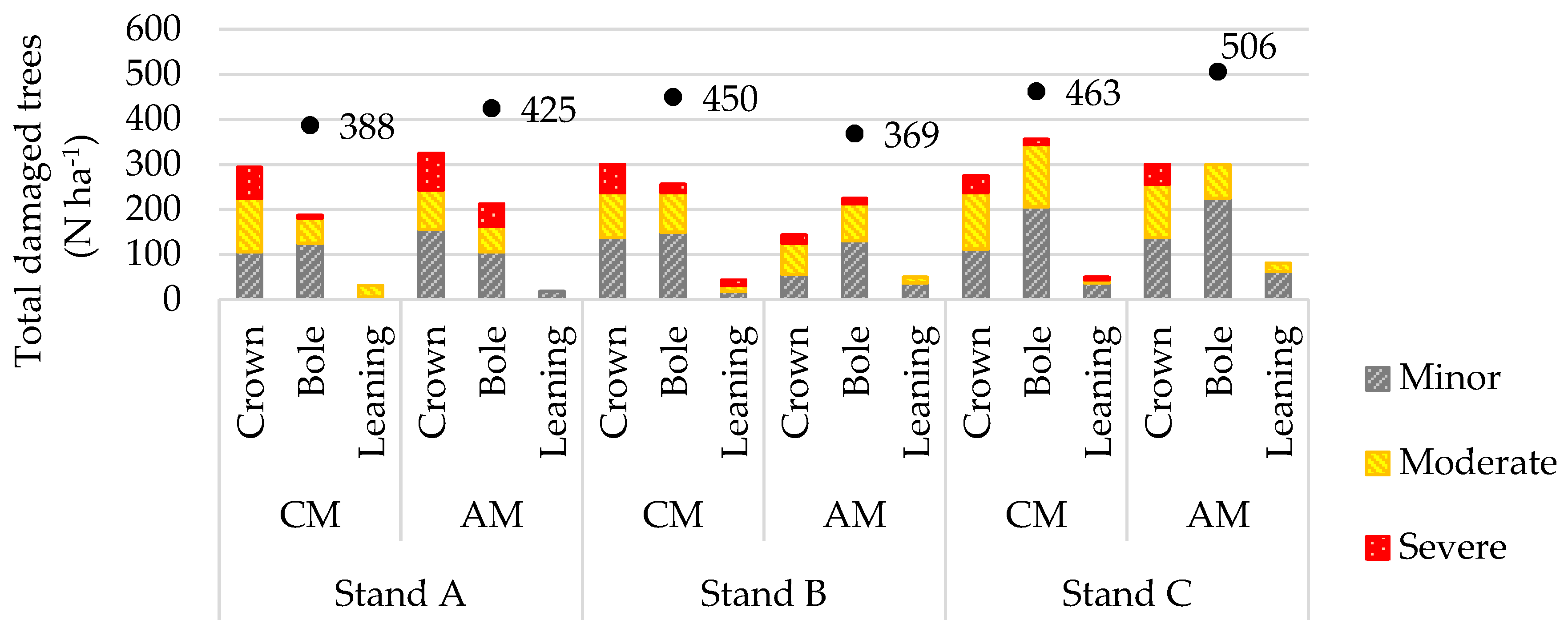

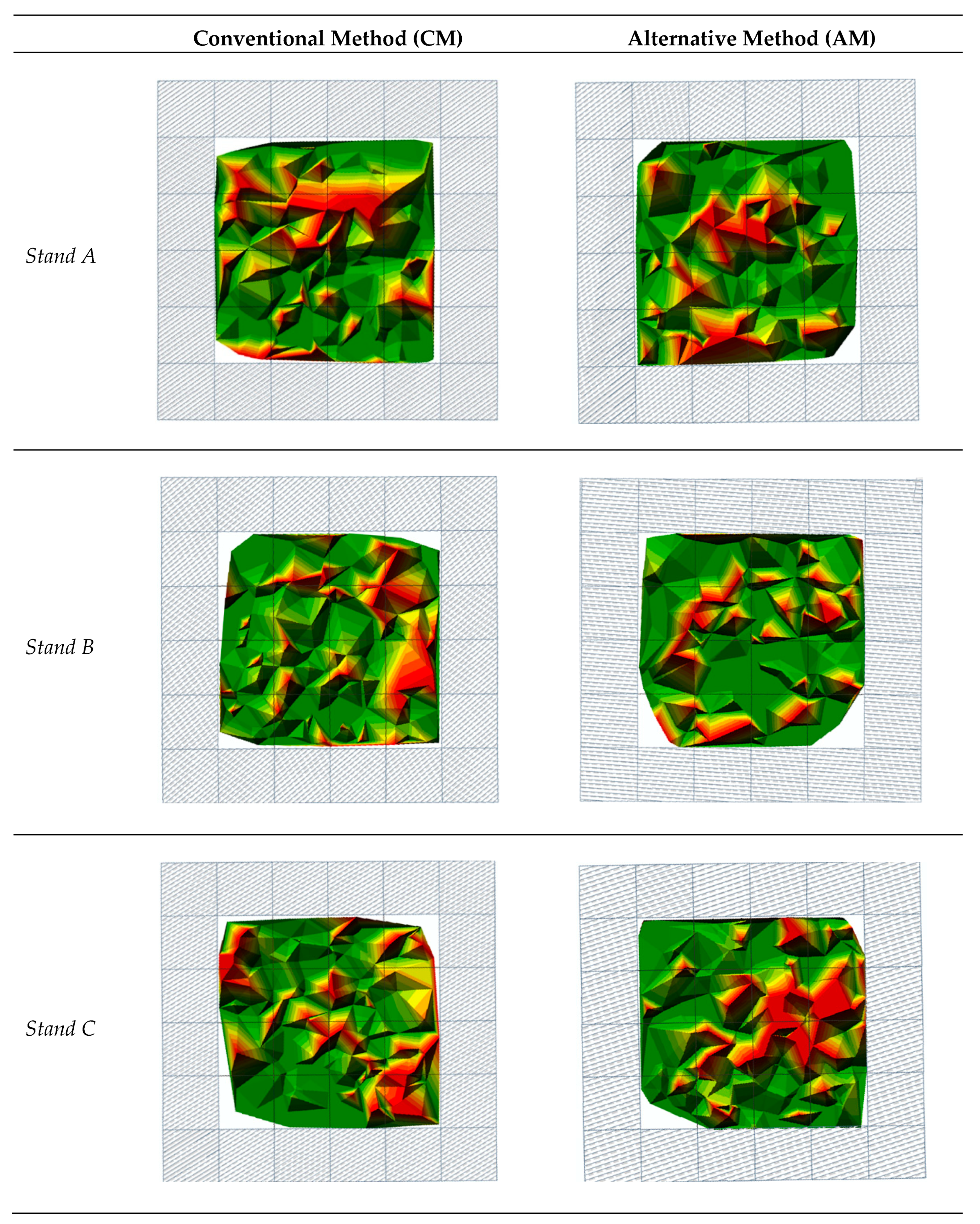

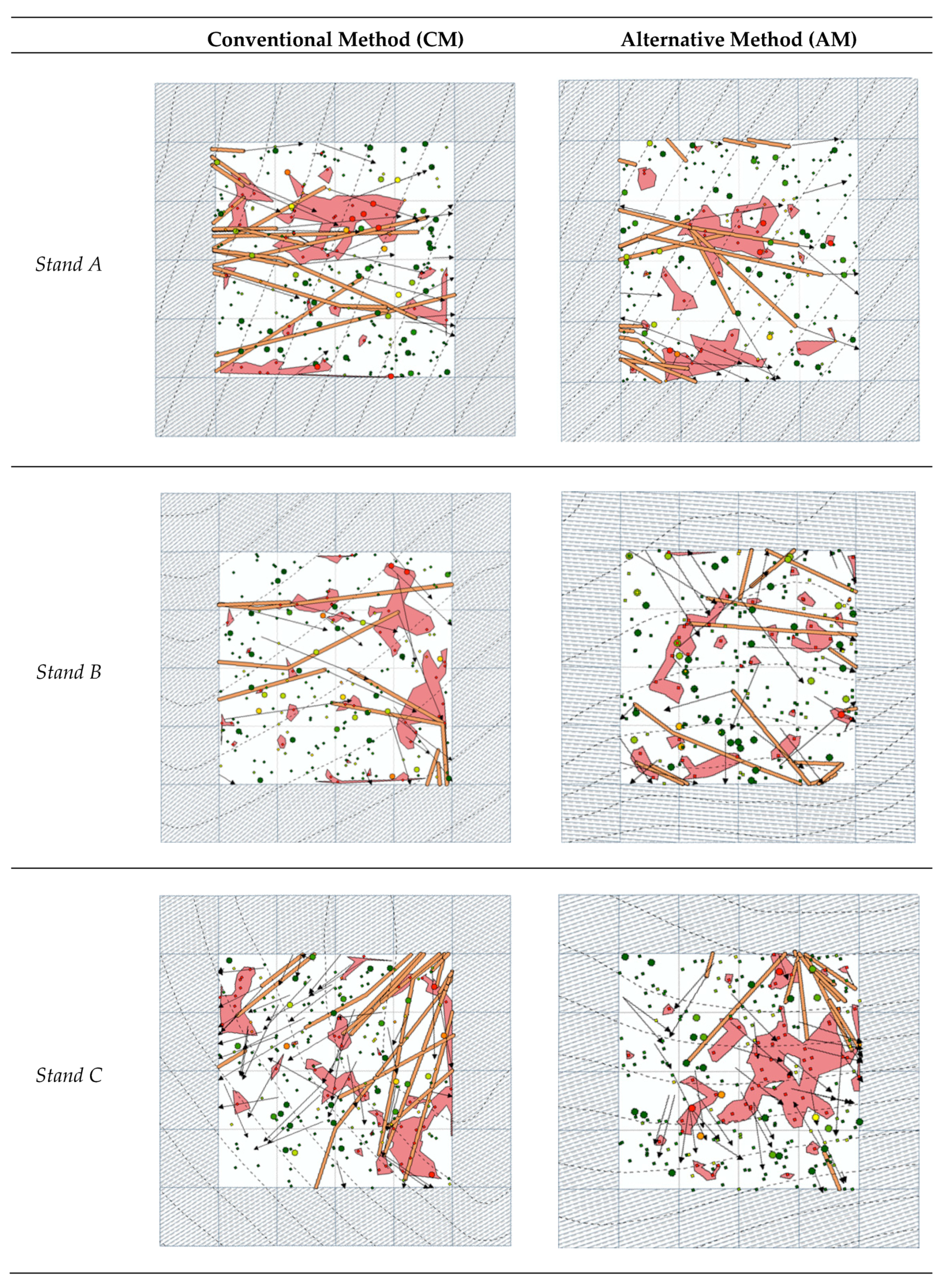

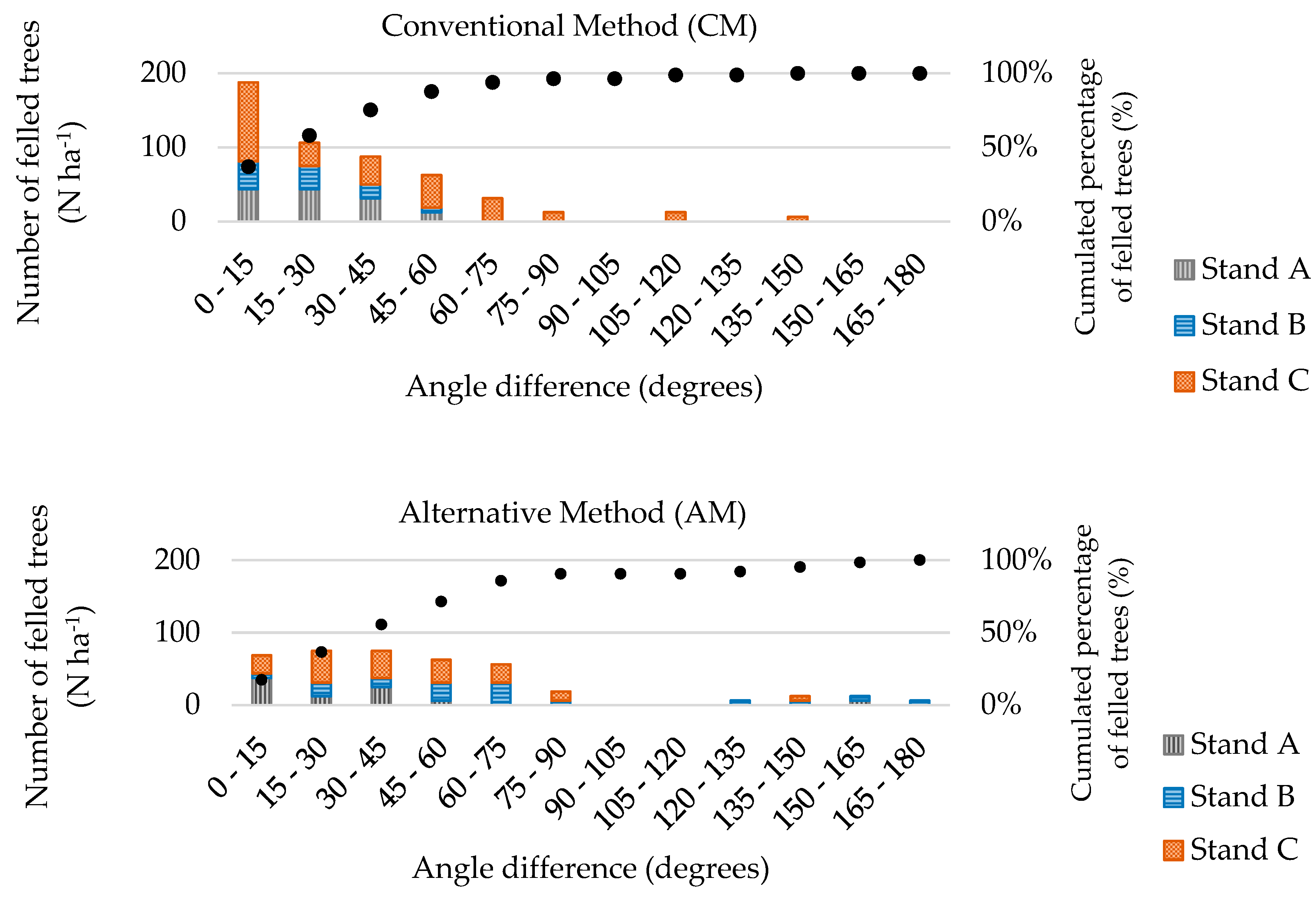
| Category of Damage | Intensity of Damage | |||||
|---|---|---|---|---|---|---|
| Minor | Rating Value | Moderate | Rating Value | Severe | Rating Value | |
| Crown damage | X < 1/3 of crown | 1 | 1/3 < X < 2/3 of crown | 2 | X > 2/3 of crown | 3 |
| Bole damage | Bark damage | 1 | Superficial wood damage (cambial tissue) | 2 | Deep wood damage (sub cambial tissue) | 3 |
| Tree leaning | Slight leaning | 1 | Partially uprooted | 2 | Fully uprooted | 3 |
| Stand A | Stand B | Stand C | ||||
|---|---|---|---|---|---|---|
| CM | AM | CM | AM | CM | AM | |
| All trees | ||||||
| Tree density (N ha−1) | 1600.0 aA | 1331.3 aA | 1456.3 aA | 1393.8 aA | 1625.0 aB | 1887.5 aB |
| Mean DBH (cm) | 14.8 aA | 15.1 aA | 12.7 aB | 14.4 aB | 13.0 aC | 11.8 aC |
| Mean tree height (m) | 9.7 aA | 9.6 aA | 10.0 aA | 10.3 aA | 10.1 aA | 9.9 aA |
| Basal area (m2 ha−1) | 39.5 aA | 37.6 aA | 24.7 aB | 30.1 aB | 28.2 aB | 29.2 aB |
| Volume (m3 ha−1) | 313.0 aA | 259.3 aA | 187.0 aB | 211.5 aB | 191.5 aB | 195.2 aB |
| Commercial species | ||||||
| Tree density (N ha−1) | 456.3 aB | 443.8 aB | 456.3 aB | 512.5 aB | 675.0 aA | 656.3 aA |
| Mean DBH (cm) | 20.0 aA | 19.2 aA | 18.1 aA | 19.4 aA | 15.3 aB | 13.1 aB |
| Mean tree height (m) | 13.5 aA | 13.1 aA | 15.0 aA | 13.9 aA | 12.4 aA | 11.8 aA |
| Basal area (m2 ha−1) | 18.4 aA | 18.8 aA | 15.0 aAB | 17.6 aAB | 14.7 aB | 10.8 aB |
| Volume (m3 ha−1) | 147.5 aA | 142.7 aA | 127.7 aAB | 133.0 aAB | 108.5 aB | 76.5 aB |
| Terrain slope (%) | ≈ 40–50 | ≈ 10–25 | ≈ 5–10 | |||
| Stand A | Stand B | Stand C | ||||
|---|---|---|---|---|---|---|
| CM | AM | CM | AM | CM | AM | |
| All harvested trees | ||||||
| Harvesting intensity (N ha−1) | 175.0 aA | 118.8 aA | 100.0 aA | 137.5 aA | 350.0 aB | 400.0 aB |
| Harvested basal area (m2 ha−1) | 13.0 aA | 10.4 aA | 6.1 aA | 8.5 aA | 11.9 aA | 10.3 aA |
| Harvested volume (m3 ha−1) | 104.1 aA | 72.6 aA | 52.9 aA | 57.0 aA | 79.3 aA | 69.1 aA |
| Mean DBH (cm) | 25.9 aA | 30.0 aA | 26.7 aA | 24.2 aA | 16.2 aB | 12.2 aB |
| Mean tree height (m) | 14.7 aA | 15.4 aA | 17.4 aA | 13.8 aA | 10.9 aB | 10.8 aB |
| Winched trees (N ha−1) | 118.8 aA | 100.0 aA | 68.8 aA | 93.8 aA | 106.3 aA | 81.3 aA |
| Commercial felling | ||||||
| Harvesting intensity (N ha−1) | 106.3 aA | 93.8 aA | 62.5 aAB | 81.3 aAB | 81.3 aB | 6.3 bB |
| Harvested basal area (m2 ha−1) | 9.6 aA | 9.5 aA | 4.9 aAB | 6.2 aAB | 4.6 aB | 0.3 bB |
| Harvested volume (m3 ha−1) | 81.5 aA | 67.1 aA | 44.4 aAB | 43.3 aAB | 32.6 aB | 2.2 bB |
| Mean DBH (cm) | 34.1 aA | 34.7 aA | 31.5 aA | 30.8 aA | 24.8 aB | 23.6 aB |
| Mean tree height (m) | 17.8 aA | 17.5 aA | 20.6 aA | 16.1 aA | 12.4 aB | 16.0 aB |
| Winched trees (N ha−1) | 100.0 aA | 93.8 aA | 62.5 aAB | 81.3 aAB | 81.3 aB | 6.3 aB |
| Improvement felling | ||||||
| Harvesting intensity (N ha−1) | 68.8 aA | 25.0 aA | 37.5 aA | 56.3 aA | 268.8 aB | 393.8 aB |
| Harvested basal area (m2 ha−1) | 3.4 aA | 0.9 aA | 1.2 aA | 2.3 aA | 7.3 aB | 10.0 aB |
| Harvested volume (m3 ha−1) | 22.5 aA | 5.5 aA | 8.6 aA | 13.7 aA | 46.7 aB | 66.9 aB |
| Mean DBH (cm) | 19.3 aA | 18.0 aA | 18.9 aA | 18.1 aA | 14.4 aB | 12.1 aB |
| Mean tree height (m) | 12.2 aA | 10.3 aA | 12.1 aA | 11.7 aA | 10.7 aA | 10.8 aA |
| Winched trees (N ha−1) | 18.8 aAB | 6.3 aAB | 6.3 aA | 12.5 aA | 25.0 aB | 75.0 aB |
| Stand A | Stand B | Stand C | ||||
|---|---|---|---|---|---|---|
| CM | AM | CM | AM | CM | AM | |
| All remnant trees (N ha−1) | ||||||
| Total remnant trees | 1425.0 aA | 1225.0 aA | 1356.3 aA | 1256.3 aA | 1268.8 aA | 1487.5 aA |
| Undamaged trees | 762.5 aA | 618.8 aA | 643.8 aA | 668.8 aA | 525.0 aA | 618.8 aA |
| Damaged trees | 387.5 aA | 425.0 aA | 450.0 aA | 368.8 aA | 462.5 aA | 506.3 aA |
| Dead trees | 275.0 aA | 181.3 aA | 262.5 aA | 218.8 aA | 281.3 aA | 362.5 aA |
| Basal area (m2 ha−1) | ||||||
| Undamaged trees | 14.3 aA | 13.3 aA | 8.8 aA | 12.2 aA | 7.0 aA | 8.5 aA |
| Damaged trees | 9.4 aA | 7.4 aA | 7.3 aA | 7.4 aA | 6.4 aA | 7.0 aA |
| Dead trees | 2.8 aA | 1.7 aA | 2.5 aA | 2.2 aA | 2.6 aA | 3.5 aA |
| Volume (m3 ha−1) | ||||||
| Undamaged trees | 102.5 aA | 98.5 aA | 61.8 aA | 87.4 aA | 49.8 aA | 58.4 aA |
| Damaged trees | 70.7 aA | 51.5 aA | 55.8 aA | 53.6 aA | 44.3 aA | 46.3 aA |
| Dead trees | 16.2 aA | 9.5 aA | 15.8 aA | 13.3 aA | 15.4 aA | 21.7 aA |
| Commercial Trees(N ha−1) | ||||||
| Remnant trees | 356.3 aA | 425.0 aA | 412.5 aA | 437.5 aA | 631.3 aB | 656.3 aB |
| Undamaged trees | 181.3 aA | 225.0 aA | 162.5 aA | 262.5 aA | 262.5 aA | 287.5 aA |
| Damaged trees | 143.8 aA | 137.5 aA | 200.0 aA | 137.5 aA | 231.3 aA | 243.8 aA |
| Dead trees | 31.3 aA | 62.5 aA | 50.0 aA | 37.5 aA | 137.5 aA | 125.0 aA |
| Commercial Basal area (m2 ha−1) | ||||||
| Undamaged trees | 7.2 aA | 8.6 aA | 4.3 aA | 7.1 aA | 4.6 aA | 5.5 aA |
| Damaged trees | 4.9 aA | 3.5 aA | 5.4 aA | 4.6 aA | 3.9 aA | 4.4 aA |
| Dead trees | 0.2 aA | 0.9 aA | 0.8 aA | 0.6 aA | 1.4 aA | 1.4 aA |
| Commercial Volume (m3 ha−1) | ||||||
| Undamaged trees | 59.1 aA | 70.3 aA | 35.7 aA | 56.1 aA | 36.0 aA | 39.3 aA |
| Damaged trees | 39.1 aA | 27.2 aA | 45.3 aA | 37.0 aA | 28.7 aA | 31.1 aA |
| Dead trees | 1.5 aA | 6.0 aA | 6.3 aA | 4.6 aA | 9.5 aA | 9.7 aA |
| Stand A | Stand B | Stand C | ||||
|---|---|---|---|---|---|---|
| CM | AM | CM | AM | CM | AM | |
| Bigger Trees(N ha−1) | ||||||
| Remnant | 462.5 aA | 518.8 aA | 575.0 aA | 437.5 aA | 493.8 aA | 437.5 aA |
| Undamaged | 237.5 aA | 256.3 aA | 325.0 aA | 200.0 aA | 225.0 aA | 193.8 aA |
| Damaged | 181.3 aA | 200.0 aA | 168.8 aA | 187.5 aA | 193.8 aA | 200.0 aA |
| Dead | 43.8 aA | 62.5 aA | 81.3 aA | 50.0 aA | 75.0 aA | 43.8 aA |
| Bigger Trees—Basal area (m2 ha−1) | ||||||
| Undamaged | 10.5 aA | 11.3 aA | 10.1 aAB | 5.8 aAB | 5.8 aB | 4.8 aB |
| Damaged | 5.8 aA | 8.2 aA | 5.9 aA | 5.6 aA | 4.8 aA | 4.6 aA |
| Dead | 0.9 aA | 1.6 aA | 1.3 aA | 1.2 aA | 1.4 aA | 1.0 aA |
| Bigger Trees—Volume (m3 ha−1) | ||||||
| Undamaged | 84.0 aA | 89.0 aA | 75.4 aAB | 45.5 aAB | 43.1 aB | 36.9 aB |
| Damaged | 43.8 aA | 64.3 aA | 46.1 aA | 46.1 aA | 34.2 aA | 33.9 aA |
| Dead | 6.1 aA | 9.8 aA | 9.2 aA | 8.9 aA | 9.5 aA | 7.3 aA |
| Stand A | Stand B | Stand C | ||||
|---|---|---|---|---|---|---|
| CM | AM | CM | AM | CM | AM | |
| TIN Most damaged plot area (m2) | 234.3 | 206.0 | 194.5 | 160.5 | 218.5 | 290.8 |
| Shortest distance from the tree location to the road (m) | 32.7 | 29.7 | 26.1 | 23.5 | 21.1 | 12.0 |
| Performed winching distance (m) | 34.8 | 30.6 | 21.5 | 19.1 | 33.7 | 13.1 |
| Estimated winching disturbed ground plot area (m2) | 200.6 | 140.5 | 105.9 | 113.4 | 184.2 | 72.0 |
| Estimated winching disturbed ground area per winched tree (m2) | 100.0 | 54.9 | 60.1 | 47.2 | 60.6 | 18.0 |
© 2019 by the authors. Licensee MDPI, Basel, Switzerland. This article is an open access article distributed under the terms and conditions of the Creative Commons Attribution (CC BY) license (http://creativecommons.org/licenses/by/4.0/).
Share and Cite
Britto, P.C.; Jaeger, D.; Hoffmann, S.; Robert, R.C.G.; Vibrans, A.C.; Fantini, A.C. Impact Assessment of Timber Harvesting Operations for Enhancing Sustainable Management in a Secondary Atlantic Forest. Sustainability 2019, 11, 6272. https://doi.org/10.3390/su11226272
Britto PC, Jaeger D, Hoffmann S, Robert RCG, Vibrans AC, Fantini AC. Impact Assessment of Timber Harvesting Operations for Enhancing Sustainable Management in a Secondary Atlantic Forest. Sustainability. 2019; 11(22):6272. https://doi.org/10.3390/su11226272
Chicago/Turabian StyleBritto, Pedro C., Dirk Jaeger, Stephan Hoffmann, Renato C. G. Robert, Alexander C. Vibrans, and Alfredo C. Fantini. 2019. "Impact Assessment of Timber Harvesting Operations for Enhancing Sustainable Management in a Secondary Atlantic Forest" Sustainability 11, no. 22: 6272. https://doi.org/10.3390/su11226272
APA StyleBritto, P. C., Jaeger, D., Hoffmann, S., Robert, R. C. G., Vibrans, A. C., & Fantini, A. C. (2019). Impact Assessment of Timber Harvesting Operations for Enhancing Sustainable Management in a Secondary Atlantic Forest. Sustainability, 11(22), 6272. https://doi.org/10.3390/su11226272





